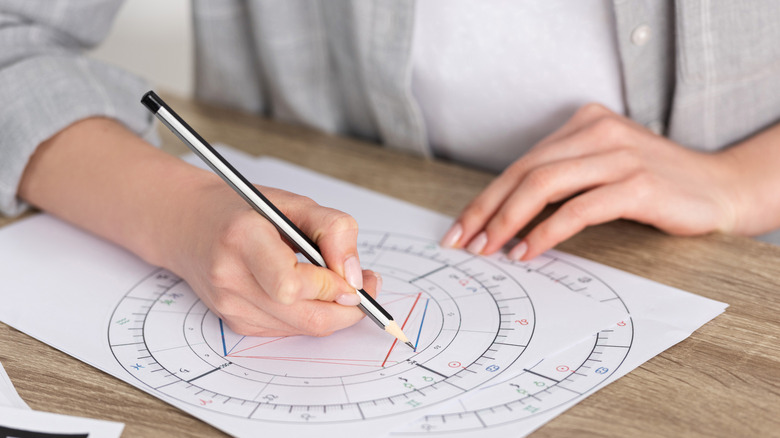Decans In Astrology Can Help You Figure Out What Planet Rules Your Placements
Astrological naysayers often pose the argument that if astrology were real, then every single person born under the same sun sign would display the same personality traits and behave the same way. Those who hold more than a passing knowledge of astrology, of course, know that a person's sun sign is only the most superficial layer of their extremely complex and unique natal chart.
Your natal (birth) chart maps out the exact location of the sun, moon, and planets relative to your location at the moment of your birth (if you don't have yours yet, grab one for free at Café Astrology). These placements are essential to understanding a person's essence, core wounds, and life's purpose. But even planetary placements don't encompass the whole picture. Each placement — including that of your sun sign — is divided into three decans, which correlate to the specific degree at which a planet is placed in your chart. Struggling to understand how to find your decans and decipher what they might mean? We've broken it down for you.
How to discover your decans and ruling planets
Each zodiac sign on an astrological chart is divided into 30 degrees, and each 10-degree segment of each sign makes up one decan. When you look at your sun, moon, and planetary placements, they will each be charted within a particular sign at the specific degree where it was located at the time of your birth. To find your decans, take note of the degrees attached to each placement. For example, your sun may be located at 2° Capricorn. This falls into the first decan, which is ruled by Capricorn's traditional ruler, Saturn, and is considered the purest representation of Capricorn energy.
If a placement doesn't fall into a sign's first decan, you will have a planetary sub-ruler different from the one ruling the sign you're in. The second and third decans are ruled by the planetary ruler of the next sign on the zodiac wheel that falls within the same triplicity — aka the same element group — of earth, air, fire, or water. So if your sun is located at 12° Capricorn, you would be considered a second decan Capricorn with a sub-ruling planet of Venus. This is because the next earth sign on the zodiac wheel is Taurus, which is ruled by Venus.
How to interpret your decans
Once you've figured out which decan your sun and other planetary placements fall into, you can move on to the fun part — interpreting them. For example, while a first decan Capricorn sun is ruled fully by Saturn and aligns with the purest, most traditional description of a Capricorn, a second decan Capricorn will not. Since a second decan Capricorn is sub-ruled by Venus, the planet of love and harmony, they will typically encompass a softer, more affectionate, and more romantic way of being than a first decan Capricorn will.
Decans apply to every placement in your chart, not just your sun sign. When you interpret your other placements in the context of decans, keep in mind the significance of that particular placement. For example, your moon placement relates to the way you experience emotions. Therefore, a person with a first decan Capricorn moon placement (0°- 9°) will more likely handle emotions in pure Capricorn fashion: cold, detached, and more like a business transaction than a matter of the heart. Meanwhile, someone with a second decan Capricorn moon placement will have a little more of Venus' warm, harmonious nature shining through the way they handle their emotions. The implications of each decan can open up a whole new world of information in your chart, so get ready to set aside a significant block of time if you're planning to check out the decans of all your planetary placements!


